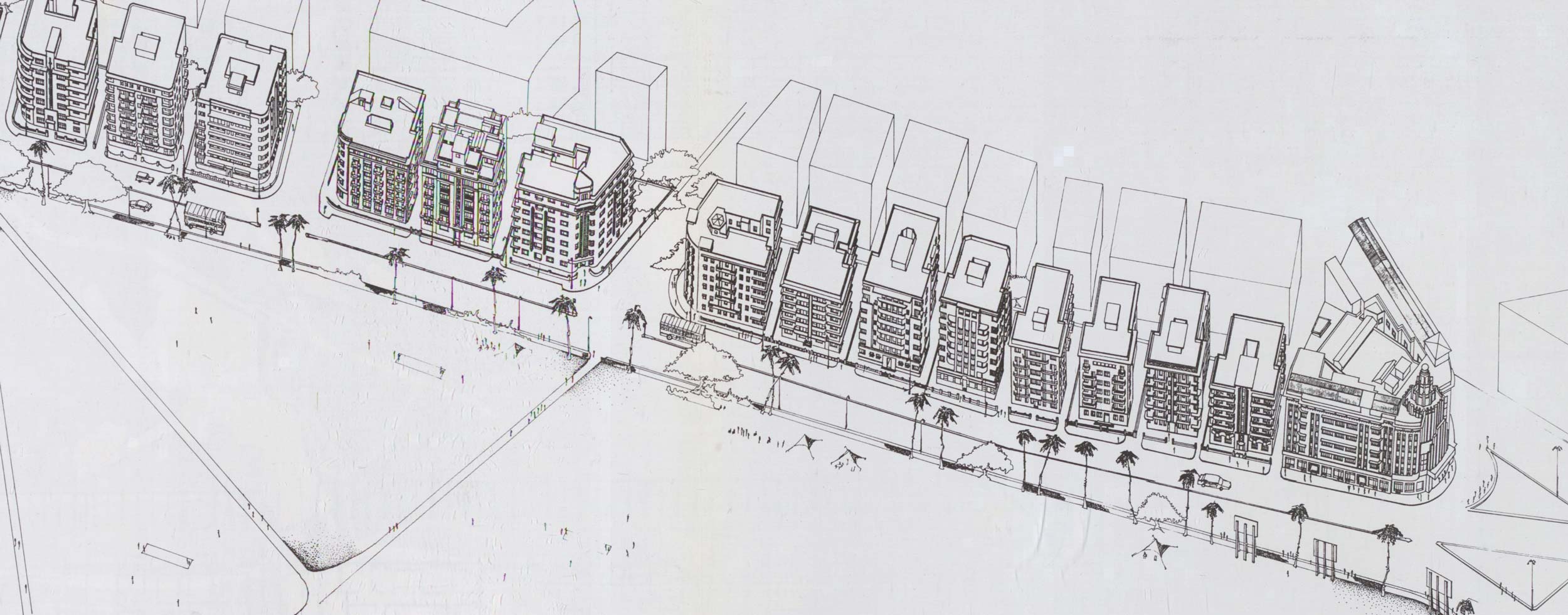Abstract
The buildings on Bombay’s Backbay Reclamations that came up in the 1930s and 1940s are now considered icons of the city and are collectively referred to as ‘Art Deco’. Two sets of buildings – the ones facing the Oval Maidan and the Marine Drive in South Bombay best represent this appellation. While their exuberant facades and their (sometimes idiosyncratic) applied ornament invite appreciation and delight in contemporary viewers, they also form connotative repositories of a time of change and modernisation, and of an international and universal outlook developing in its citizens. In the current literature, these buildings have been largely studied from a historical/ stylistic perspective, placing them synchronously in the development of Bombay’s/India’s architecture in the early 20th century.
We assert that an ahistoric re-examination, by reading these buildings semiotically as a system of signs, would elicit more useful meanings leading to a better understanding of the architecture of the period. With this in mind, we examine the facades of the Oval Maidan and Marine Drive buildings as agglomerations of semes (basic meaning trait or distinguishing quality) that connote references and concepts that express their age. Using analytical models from visual semiotics (described variously by Saussure, Greimas and Matozzi), we examine the facades as texts, breaking them down for syntax (the order of the elements) and collating the semes to form isotopies (repetitions of traits).
In order to articulate isotopy usefully, two terms are also coined- ‘enhancers’ or semes that synchronically work with architectural elements and ‘nuancers’, the diachronous, often iconic ornament-semes on the building. Semiotic isotopies formed by enhancers and nuancers are then analysed for connotative meaning to chart a narrative of the architecture. Through the uniform readings so found, we position the Backbay buildings as speakers for the city’s emerging modernity.
Introduction
The buildings of the Oval and the Marine Drive are part of a larger set of buildings erected during the 1930s and 1940s in Bombay and the rest of India, using mass produced materials such as cement, steel, glass and associated products. They share several features in common, and exhibit affinities in design and ornamentation. Collectively and retrospectively these buildings are referred to by a historic/stylistic appellation- Art Deco.
Previous studies of Bombay’s Art Deco architecture present a broadly historical viewpoint. To a large extent, they are placed in a stylistic chronology of Bombay’s/ India’s contemporary architectural development, extending back from the late 19th century period of different ‘revivals’ through to the post-independence High Modernism of Le Corbusier and Kahn, and the Indian architects who came in their wake. In such a chronology, these buildings remain a historical punctuation rather than stand their own ground. We assert that contemporaneity is best seen on the facades of these specific buildings, which used both architectural elements and architectural ornament to convey the zeitgeist of the period. Modernity is valorised on their facades both overtly as well as unselfconsciously, reflecting the spirit of the age in the act of architecture. Current literature does not examine the facades of the buildings in this light but more as decorative or ornamental tropes, en-vogue at the time. This is a gap we attempt to address through this paper.
Thus, by looking at the buildings of the Backbay reclamation through an ahistorical (semiotic) lens, we seek to and expressions of a city in the throes of modernization. These expressions can be best observed on their facades. We attempt this by examining the formal qualities of the buildings as well as various denotative and connotative elements on the facades, collating semes (a basic meaning trait or distinguishing quality) to form isotopies (repetitions of traits). Using analytical models from visual semiotics (described variously by Saussure, Greimas and Matozzi), we read the facades as texts.
In order to articulate isotopy usefully, two terms are also coined- ‘enhancers’ or semes that synchronically work with architectural elements and ‘nuancers’, the diachronous, often iconic ornament-semes on the building. Semiotic isotopies formed by the enhancers and nuancers are analysed for connotative meaning to chart a narrative of the architecture. This paper attempts to seek meaning from the architectural articulation and renditions of ornament on the facades of these buildings. Considering the Backbay buildings as signifiers (visual or textual parts of a sign system), we shall study the manner in which architecture elicits semiotic meaning. Through the uniform readings so found, we position the Backbay buildings as speakers for the city’s emerging modernity.
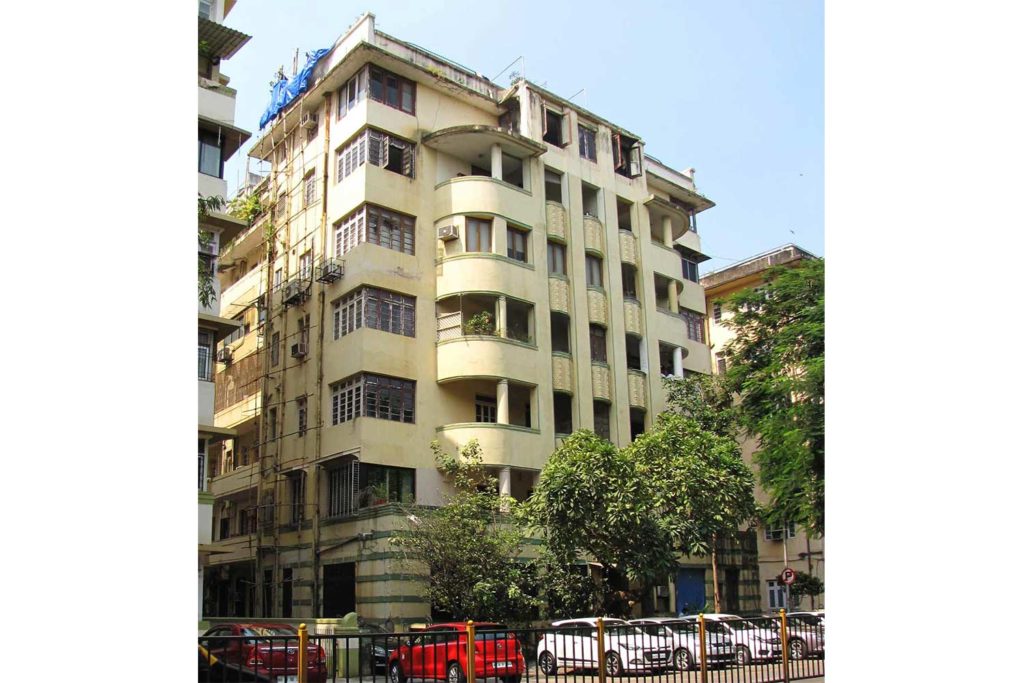
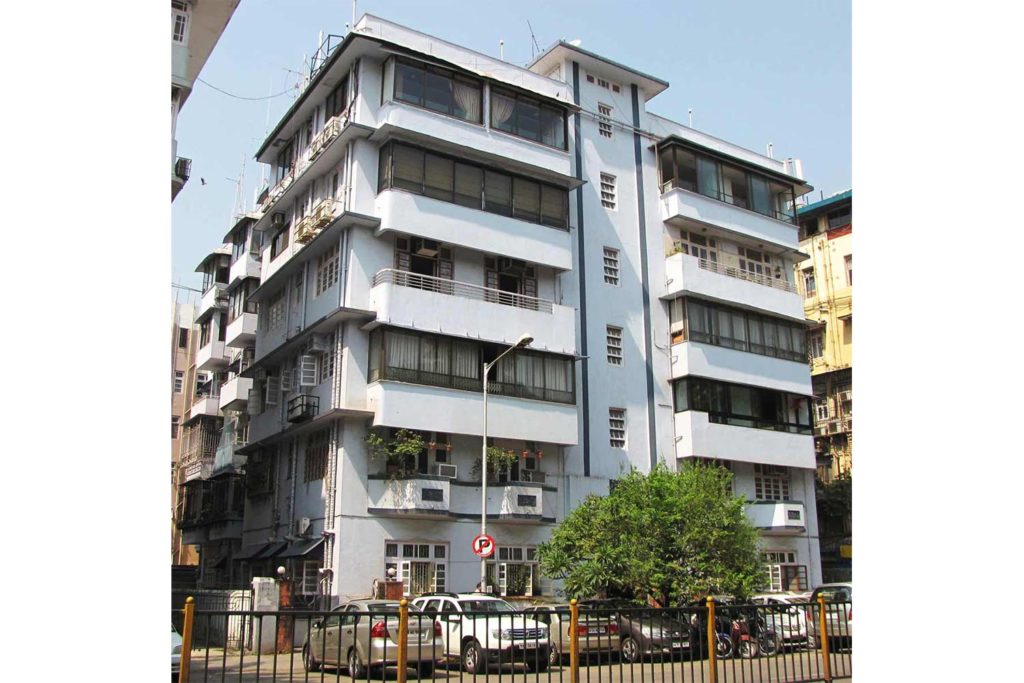
Architecture in ‘the life of its time’
In the early 20th century, Bombay was energised by the spirit of its age. In the last quarter of the 19th century the city had been transformed through civic works, infrastructure and great architecture. Its citizens reaped the benefits of technology, education and public health. Mobility was on the increase and the availability of goods of mass consumption, and public entertainment impacted every citizen.
Modernity1, as it emerged in the early decades of the 20th century, was an assimilation of new technologies, operated on a mass scale, for mass consumption. This included the new modes of transport like automobiles, trains, aero-planes, steamships; new materials like reinforced concrete, steel, plate glass, ceramics, dyes; new media like cinema, photography, telephony, the typewriter, the gramophone using new sources of power and energy like oil and petroleum, electricity, the internal combustion engine and the diesel engine.
As far back as 1901, the architect and theorist Hermann Muthesius (pp. 364-5) mentions how “Art supports itself on the life of its time […] The elegantly built sailing vessel shooting across the water’s surface, the electric lamp and the bicycle- these seem to capture the spirit of our time”. In the 1920s, according to Bevis Hillier (1998, p. 90) in ‘The Style of the Century’, the decorative arts became altogether more purposeful to match the new zeitgeist of society: “The decorative motifs of the 1920s […] gave place to the more hard edge dynamic motifs of the 1930s, such as the zigzag of […] electric power and radio waves […] and above all the sun ray, which appeared on almost anything from gramophone needle boxes to suburban garden gates.” In the seminal exhibition- ‘Modern Architecture’, at the Museum of Modern Art, New York, Hitchcock and Johnson (1932, pp. 19-20) attempted a trans-global definition: “This contemporary style, which exists throughout the world, is unified and inclusive, not fragmentary and contradictory like so much of the first generation of modern architects.”
The architecture from the thirties onwards was non-monumental for most part, urbane in nature and used a form of building construction and architectural expression that reflected the contemporary.
Bombay’s architecture in the 1930s and 1940s
In Bombay, by the end of the first two decades of the 20th century, most buildings of the Colonial enterprise were already built. The last of the imperial buildings erected in Bombay was the Gateway of India (1924), commemorating the visit of George V in 1911. The newer buildings from the late 1920s onwards were, to a large extent, commercial office buildings, cinema houses and residential buildings. These were prolific and defined the urban fabric of the city in the second quarter of the 20th century.
What makes these buildings significantly different from the official buildings of the Raj is that they were designed by Indian architects. These were architects who had graduated from the Sir JJ School of Art in Bombay and had set up practices in the city in the 1930s. They also included several teachers from the School who had some of the biggest architectural practices at the time. The most significant of these were the firms of Gregson, Batley and King, whose partner Claude Batley also headed the Department of Architecture at the School of Art from the twenties to the forties and Master, Sathe and Bhuta, whose principal C. M. Master succeeded Batley. Other Indian firms like Merwanji Bana and Company, Bhedwar and Bhedwar, Suvarnapatki & Vora, and individual architects like G B Mhatre, Maneck Davar and Abdulhusain Thariani were also prolific.
The Indian architects chose a language of architectural expression that was different from the colonial practice, which was essentially revivalist, having gone through phases of Neo-Classical, Neo- Gothic and the short lived but significant, Indo-Saracenic. The architecture from the thirties onwards was non-monumental for most part, urbane in nature and used a form of building construction and architectural expression that reflected the contemporary. The buildings were constructed using reinforced cement concrete (RCC) frames and were finished with plaster, glass and other modern materials. These buildings also displayed a variety of applied ornament that was without precedent. Another reason this architecture gained widespread acceptance was due to its unabashed promotion by cement companies. The Associated Cement Companies Limited (1937) and The Cement Marketing Company of India Limited (1942?) published annual brochures showcasing the buildings produced during the year.
The first two decades of the 20th century Bombay also saw a considerable realignment of the peninsular edge, especially the southern and western edge through several projects of reclamation. The 19th century had seen the knitting together of the former islands that constituted what would later become Bombay City and its integration with Salsette that would define the beginnings of Bombay’s suburbs. Later reclamations went through several iterations to create urban edges to the city’s connection with the sea. These reclamations came to be known as the Backbay. Significantly, this also resulted in the creation of the new plots to the west of the Oval Maidan, and the Queen’s Necklace on Marine Drive, the crescent edge that gave Bombay one of its most important and now well-loved and iconic urban image.
In conjunction with urban redesign, new urban planning schemes in the Backbay were created through reclamation for the building of residential and commercial buildings. Two of these schemes were important groupings of residential buildings that are the object of our study in this paper. The first was facing the Oval Maidan and the second the set of buildings that lined the Marine Drive. Both of these were built on planned, plotted developments that created largely similar sized plots for the construction of residential apartment buildings, all aligned along a frontage and having the same height and floor lines. The reclamation work to the west of the Oval Maidan was completed by 1929, while the Queen’s Necklace of the Marine Drive was completed by 1940.
These are the buildings that were designed by a new generation of Indian architectural practices. Quite aware of the happenings in the architectural world at large, and of the sweeping changes in the years between the world wars, these architects chose a language that synthesised functionalism, expression and abstract/ figurative ornament. In a sense, these buildings themselves form narrative devices of their time.
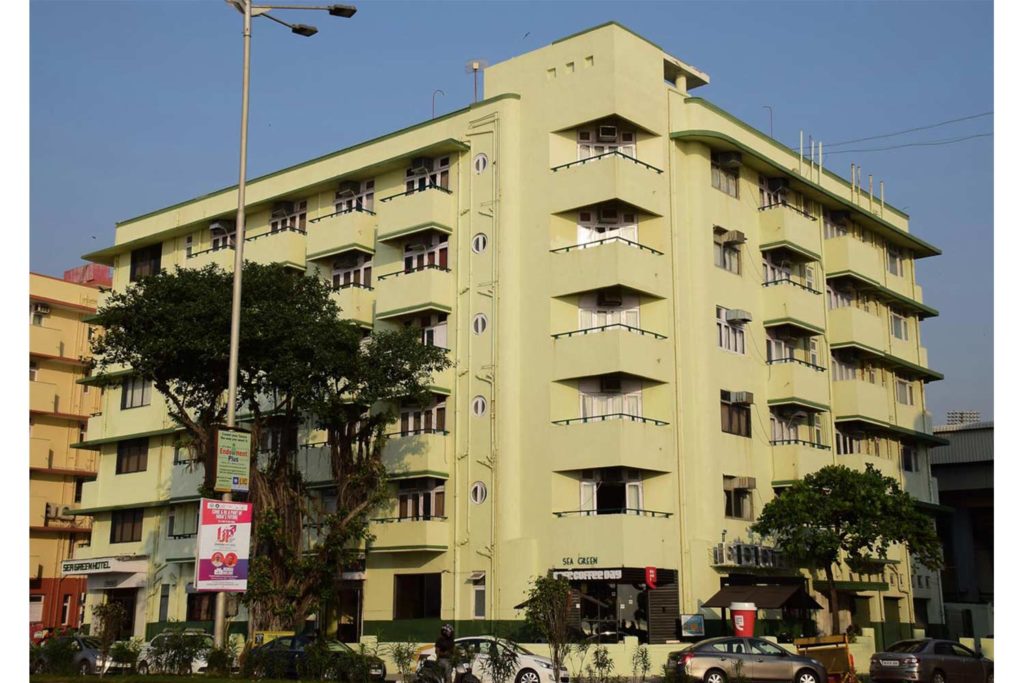

Art Deco Architecture in Bombay
Today, the buildings facing the Oval Maidan and those that line the Marine Drive are appreciated as some of contemporary Mumbai’s most loved landmarks, and are referred to in academic journals and popular guidebooks alike as Art Deco. Art Deco is generally thought to straddle several iterations, from the fashionably ornamental to the streamlined and also incorporating local variations and adaptations.
While Art Deco has different resonances based on where such buildings were built, there are both variations and commonalities in its description. Beavis Hillier in his book, ‘Art Deco of the 20s and 30s’, has attempted a clear (and now canonically accepted) definition of Art Deco (as cited in Benton & Benton, 2003, p. 17): “An assertively modern style, developing in the 1920s and reaching its high point in the 1930s… a classical style in that, like neo-Classicism, but unlike Rococo or Art Nouveau, it ran to symmetry rather than asymmetry, and to the rectilinear rather than the curvilinear, it responded to the demands of the machine and of new materials… (and) the requirements of mass production”. Michael Windover (2011, p. 2) finds mobility is “present on the very surfaces of Deco objects and architecture—in iconography and general formal qualities (whether the zigzag rectilinear forms popular in the 1920s or curvilinear streamlining of the 1930s)”.
Art Deco architecture displays a variety of conventions derived from a multitude of sources, some classically universal and some that were fashionable at that time. Typically, its imagery freely sources trends like the Machine Age, as seen in the skyscraper; the avant-garde in art and movements like the Bauhaus or Futurism; fashions like the very popular Ballet Russes, Hollywood Films, and Jazz; such objects of desire like products, jewellery and objects d’art; photography; exotic locales like Africa, Greece/ Rome, Egypt and the (then) newly discovered tomb of Tutankhamen and the riches that emerged from it; Far East, India, Maya/Aztec; World Fairs like the Exposition des Arts Decoratifs (Paris,1925); speed in the form of automobiles, trains, ocean liners and nautical motifs. These and other characteristics and variations of Art Deco architecture have been explored in detail in the writings of Bhaskaran (2007), Bayer (2003), Miller (2005) and Gagliardi (2006).
In the context of Bombay, Amin Jaffer (2010, pp. 383-384) describes the Backbay buildings as “a consistent architectural style (that) resulted in a coherent Art Deco cityscape second in size only to Miami’s South Beach. Its buildings are all characterised by concrete construction, flat roofs and curved fenestrations”. Ramani (2007) and Lang (2010) have listed several motifs and tropes on the Backbay buildings. These authors and researchers have considered Art Deco from a largely historical angle, and its characteristics as stylistic tropes.
The building as an Object for signification
The architectural critic Charles Jencks describes the fundamental idea of meaning in architecture thus: “the idea that any form in the environment, or sign in language is motivated, or capable of being motivated… the minute a new form is invented (or noticed) it will acquire, inevitably, a meaning”. Jencks (1969, pp. 11-13) quotes Roland Barthes: “This semantisation is inevitable: as soon as there is a society, every usage is converted into a sign of itself”. If meaning is to be sought to be found in the Backbay buildings, tools of semiotic analysis shall have to be adopted to understand the buildings themselves. The intention is to see what these buildings can tell us about their time, through the expressions employed on their surface. Our study shall analyse facades, deconstructing their narrative syntax.
Breaking down the façade into its component elements and studying their relations to one another allows us to articulate the façade’s syntax. Studying the component architectural schema and the layered ornament on the buildings gives us semantic clues in terms of references and influences eliciting meaning. Narrative syntax, or the manner in which constituent parts of the façade relate to each other, in our study, is informed by the work of Alvise Mattozzi, specifically his paper, ‘A Model for the Semiotic Analysis of Objects’ (2009), where he attempts to account for the way in which an object signifies or takes part in the articulation of meaning. He uses a contemporary object- Philip Stack’s Juicy Salif to illustrate narrative syntax and the meanings that accrue. Isotopy, or collections of meaning traits in our survey is informed by the work of Algirdas Julien Greimas, and referenced from Daniel Chandler (2010) and Louis Herbert (2009).
The intention is to see what these buildings can tell us about their time, through the expressions employed on their surface. Our study shall analyse facades, deconstructing their narrative syntax.
From Saussurean semiotics- a ‘sign’ is composed of a ‘signifier’ (a verbal, textual or imagistic description) and a signified (that which the description refers to). The word, a spoken word or a picture of a ‘horse’, a signifier, refers to the animal itself, a signified. A signified may be made up of several individual elements or ‘semes’ that give meaning. If semes are repeated, they form ‘isotopies’, or ‘bundles of isotopies’ which give larger meaning to the signified (Hebert & Everaert-Desmedt, 2011). Isotopy2, thus, according to Greimas (1966) is a repetition of a basic meaning trait that establishes some level of familiarity and allows for a uniform reading/interpretation of an object (as cited in Hebert, 2009). Thus, for example, a circular shaped window is identified as a seme. Seen in conjunction with other semes, say a compound-wall grille shaped like waves or surf, or a railing designed in the manner reminiscent of a ship’s deck can, all together be seen as an isotopy, that connotes a nautical or maritime referent.
As mentioned earlier, the two sets of residential buildings taken for investigation have been already appreciated historically for bringing a unified urban aspect to the precinct in Bombay where they are located. The first set of buildings is on Maharishi Karve Road flanking the Oval Maidan, the primary showpiece of Art Deco architecture in Mumbai. The Oval Maidan Buildings are, among others, Court View, Green Fields, Queen’s Court, Empress Court, Rajjab Mahal, Palm Court, Ivorine, Sunshine, Moonlight and Firuz-Ara. These buildings were erected between 1935 and 1938. The second set of buildings was constructed in the early and mid-1940s on the newly completed Queen’s Necklace sea face on the Marine Drive or Netaji Subhash Chandra Bose Road. These buildings include, among others, Oceana, Sea Green, Soona Mahal, Sunder Mahal, Framroz Court, Chateau Marine, Krishna Mahal, Keval Mahal, Kapur Mahal, Zaver Mahal, and Matru Chhaya.
Several of these buildings have undergone extensive remodelling or have been gutted to a point where the original facades have been lost. Only those that are well preserved are useful for this study.
For our purposes, a limited study is undertaken-two building each from the Oval Maidan set and the Marine Drive set have been examined in detail for syntax and isotopy. We have chosen Green Fields (Figure 1) and Court View (Figure 2) from the Oval Maidan and Sea Green (Figure 3) and Soona Mahal (Figure 4) from the Marine Drive. These buildings may be considered representative of the sets they are chosen form. They have been selected for the diversity of expression of their facades- from ornamental to ‘stripped-down’ versions. Both sets have distinguishing characteristics that define their narrative syntax and ornamental schema.
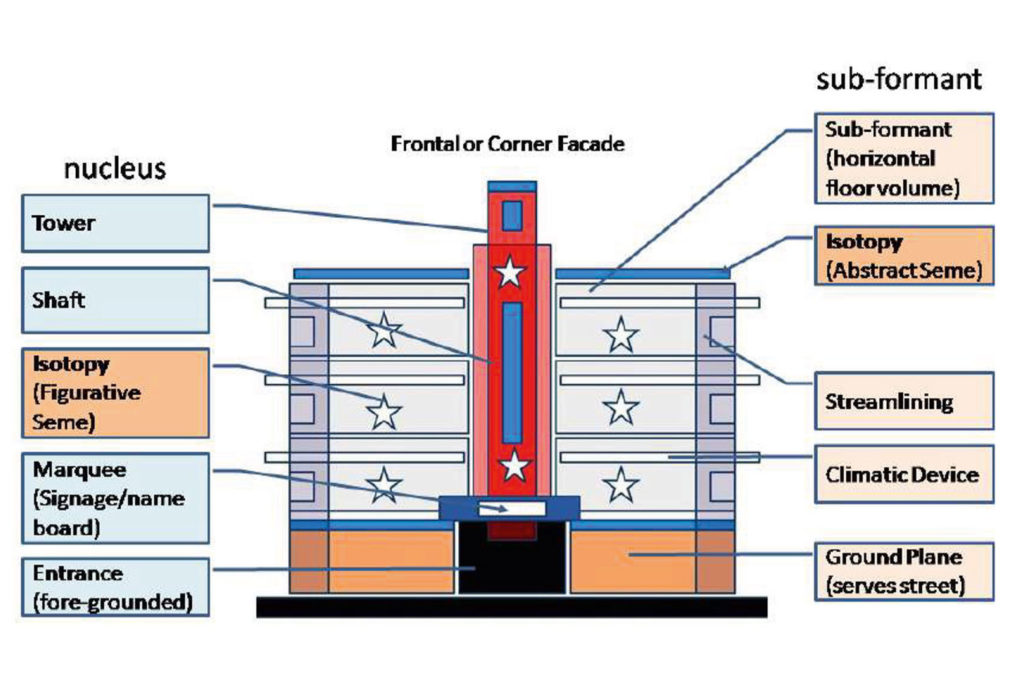
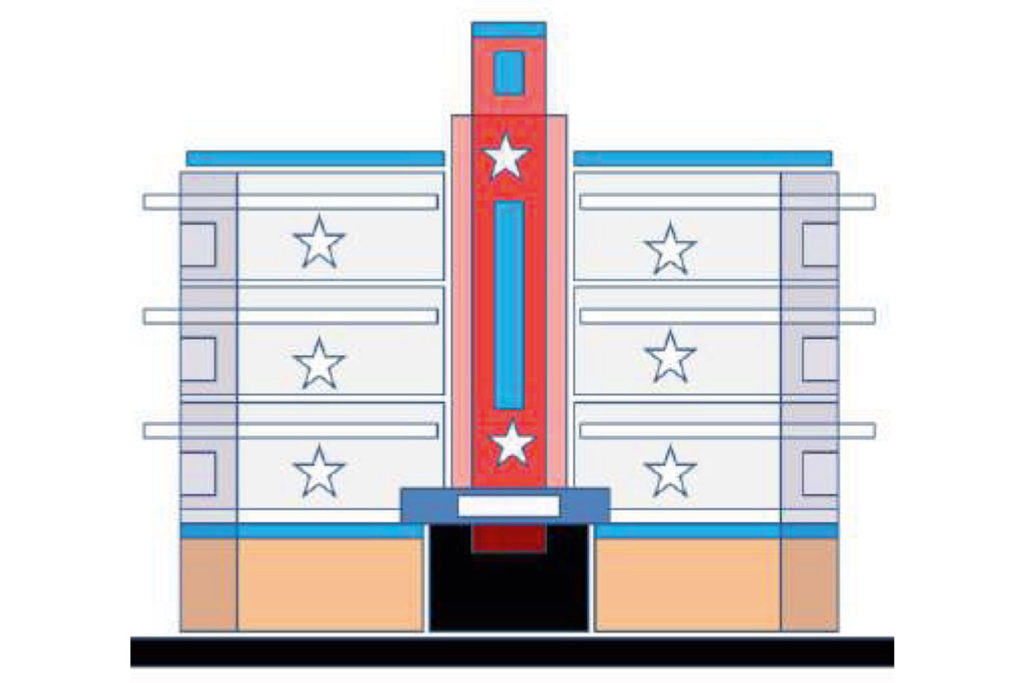
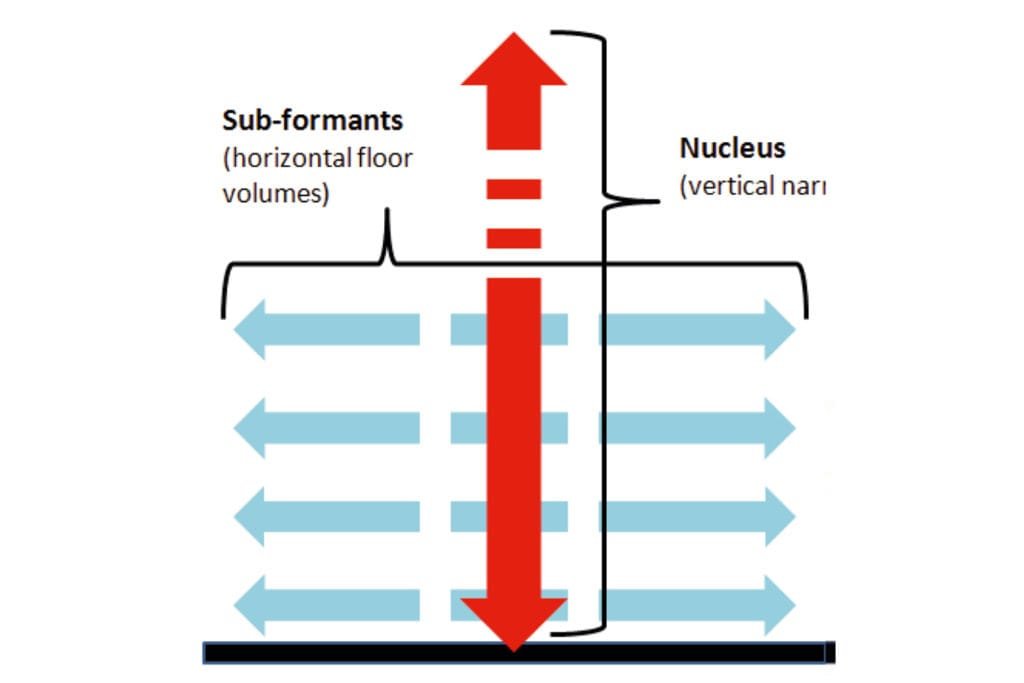
Narrative Syntax of the Backbay Reclamation Buildings
Both the Oval Maidan Buildings and those along the Marine Drive are articulated in a narrative syntax that arrayed around a dominant axis that is largely self-similar and predictable. Here, the axis of symmetry is highlighted by a strong architectural element that rises through the buildings and emerges above the building line as a dominant element in the skyline. We refer to this element as a ‘nucleus’3, after (Mattozzi, 2009). The nucleus is a singularity (Figure 5) that creates a configuration of the vertical axis that is also the pivot for the general symmetry of the building. In the case of the buildings under study, the nucleus is the articulated stairwell of the building (Figure 6), which as it rises vertically, overtly breaks down into series of narrative ‘discontinuities’ of component parts like the entrance way, the marquee, the shaft, and the tower.
While the nucleus foregrounds itself on the façade of the building, it also helps articulate the body of the building, usually spread out in two wings to its left and right. We refer to 4 these as ‘sub-formants’4 (also, after Matozzi). On a building, the sub-formants can be seen (Figure 7) as the individual floors of the building articulated not only to form architectural elements such as cantilevered balconies and (often grilled) fenestrations, but also as climatic devices or protective formations against the weather, like chajjas and canopies.
As is evident, when syntactically broken down (see Table 1), there is a noticeable self-similarity in all four buildings in their overall profile (all the buildings are stepped and display axial symmetry). We identify this as the first layer of a three layered scale (going from larger to smaller) on these buildings.
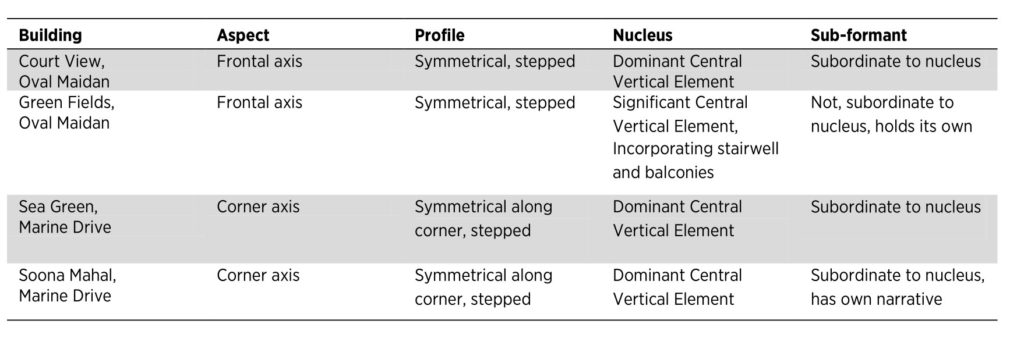
There are however, some variations in the nucleus of each of these buildings. While all are vertical, some dominate the façade whereas others share a more integrated relationship with sub-formants. All the nuclei are stairwell that rise along the axis of symmetry, yet Court View and Green Fields manifest on the front of the façade while Sea Green and Soona Mahal have dominant nuclei on the corners. The sub-formants too vary, ranging from a presence that is effectively back-grounded to the nucleus in Court View and Sea Green while holding its own in Green Fields and Soona Mahal. Each façade, in the case of Sea Green and Soona Mahal appears asymmetrical when seen from one side, or in elevation, with the dominant nucleus at one end.
A second level of layered scale is visible, that is an enumeration of syntax created by architectural elements that make up the nucleus and the sub-formants of the buildings. These include organisational elements like streamlining, tiered/stepped framing, curves, angles, symmetry, asymmetry, horizontality, strong lines; or architectural elements like base floors, undulating, repeating patterns, bold, orderly forms, flat roofs, signage, rounded corners, wraparound windows, porthole windows, eyebrows, smooth walls, white walls, railings and balustrades, grilled fenestration, grilled compound walls and gates. Both organisational elements and architectural elements are layered to build up the facade.
A third level of layered scale is seen in the form of abstract and figurative ornament, usually applied on the buildings, most notably on the nucleus and occasionally on the sub-formant (indicated by stars in Figures 6 and 7). Ornament is also articulated within architectural elements like columns, balconies, building edges and fenestration, described in the second layer.
Each layer provides individual semes (signifieds) that have connotative meaning, and combine to form isotopies. Isotopies on the buildings form bundles of meaning that can be read in conjunction across levels and provide readings into the architecture. We identify these semes to appreciate the isotopies created by them. Each building can therefore be best perceived as a palimpsest of layers, each marking its presence as a meaning giver.
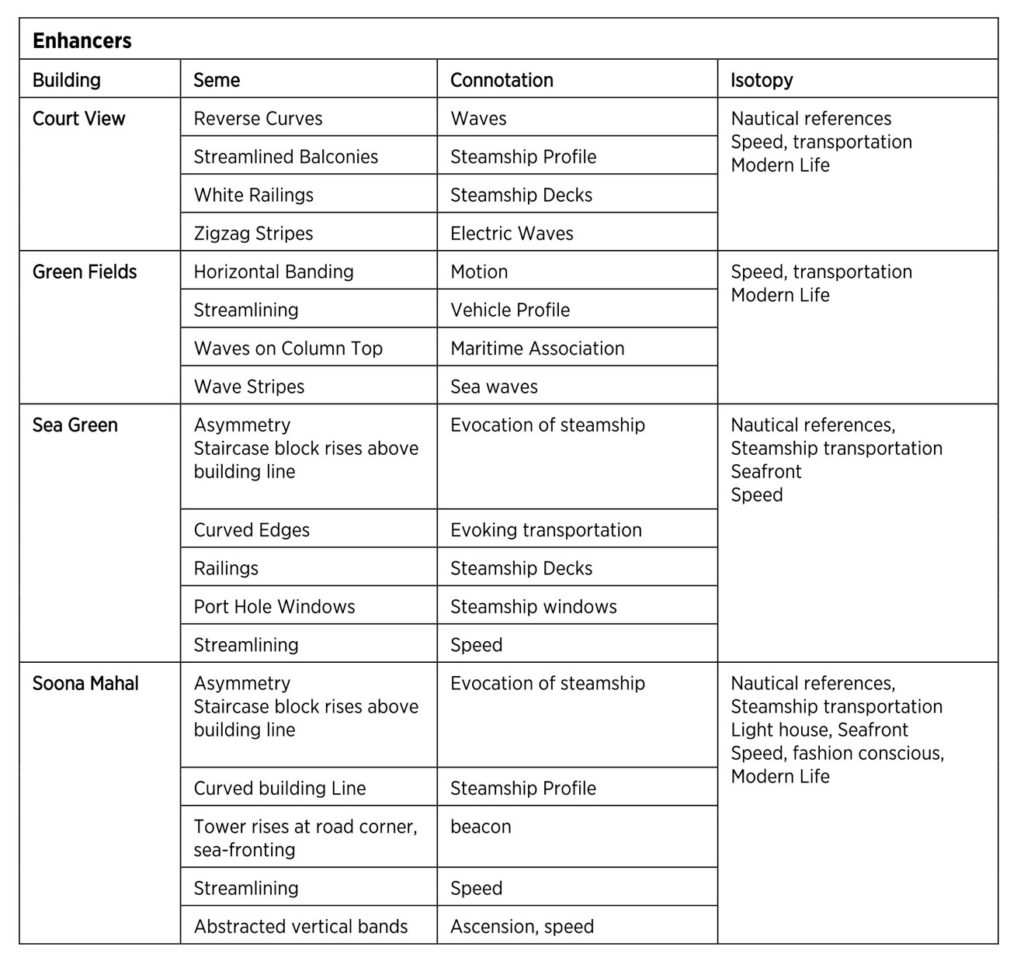
Isotopy on the Backbay Reclamation Buildings
To locate isotopies on these four buildings, we coin two new phrases: ‘enhancers’ and ‘nuancers’. Both enhancers and nuancers make their presence felt on the identified buildings, but in different ways.
Enhancers are semes that synchronically work with the architectural elements themselves. They are architectural- semes (Table -2). They enhance the architectural articulation by foregrounding, or underlining its importance on the layered facades. Enhancers bring visual richness to architectural elements, through various patterns, bands and colour (Layer 3, as described earlier). Streamlining, using building up tiered frames (Layer 1) or repetitive patterns like banding (Layer 2) may also be considered as enhancers. These are Art Deco conventions as well. These semes collectively form isotopy. However, hypothetically, if the enhancers were to be removed, the layers of architectural articulation could still stand, albeit in a ‘stripped-down’ version.
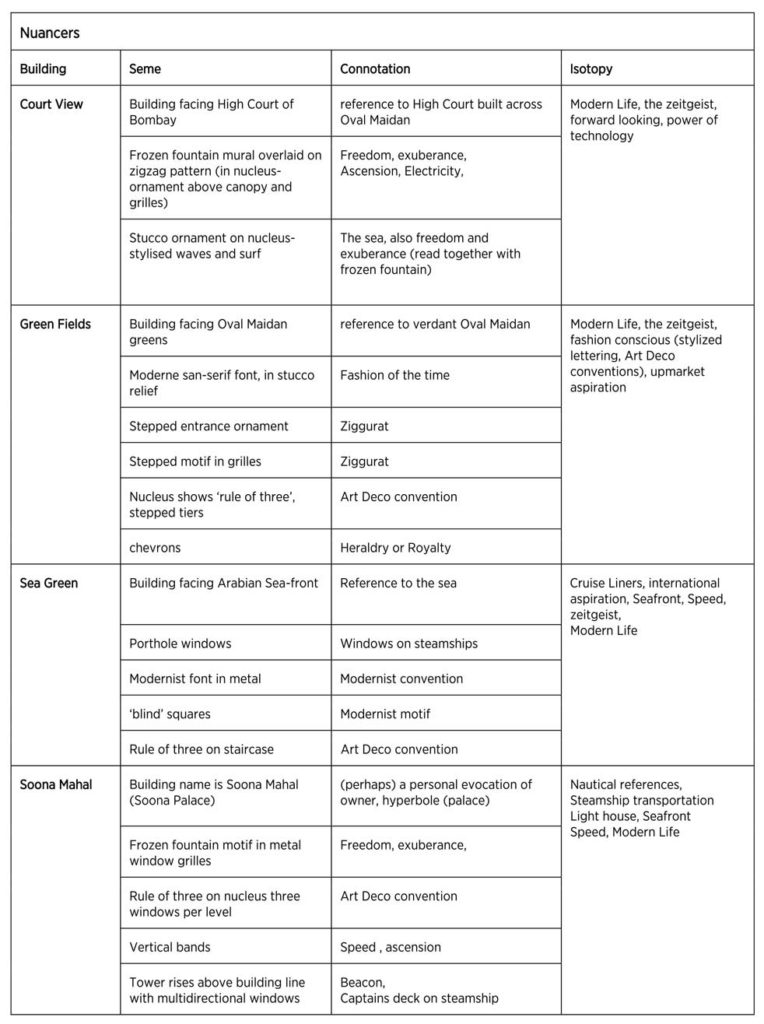
Nuancers are the diachronous, often iconic ornament-semes on the building. They are chosen as part of a thematic brief, often in conjunction with the building’s name or its location. These themes often reflect the various Style Moderne5 conventions of celebrating modernity in the form of the fast paced urban life, evoking the speed of modern transport like a train or steamship. Sometimes the themes may evoke water or marine concepts.
Nuancers are ornament-semes that carry the theme on the building facade in several manifestations such as relief murals, entrance gates, window and staircase grilles, etc. (Table 3). These semes display a stylised geometry that can be seen in the form of chevrons, sunbursts, zigzags, waves, highly stylized icons, musical notes, symbolic meanings, stylized flowers, stylized birds, machine gears, flowing waterfalls, fountains, stylised foliage, signage, humans in relief, dynamic activity. All these are Art Deco conventions.
Analysis of Narrative Syntax and Isotopy
Diversity in the forms of variations on facades of the Backbay Reclamation buildings is best seen at the intermediate scale of architectural- semes. Thus despite the visual variations when these buildings are observed in their overall aspects, that ranges from the highly ornamental to ‘stripped down’ modernism, it is here that the buildings exhibit the most commonalities.
In terms of ornament, the enhancers are much more widespread than the nuancers (see Tables 2 and 3). In the case of the Oval Maidan buildings there is a greater uniformity of the ‘ornamental brief’ and its execution on the facades. In both Court View and Green Fields, as seen, water motifs semes are present overtly as well as subtly in the building forms. On the other hand the Marine Drive buildings, as seen in Sea Green and Soona Mahal, use ornament, sparingly nuanced, but build up the larger scale of architectural form to respond to their position on the seaface.
All four buildings develop the nucleus/sub-formant dialectic, in the form of a narrative syntax that rises from the base floor and culminates above the building line in the form of a tower or staircase block. Thus, even if we suppress nuanced ornament, the buildings still show a remarkable commonality at the level of the architectural semes.
One enhancer, the Art Deco convention of ‘streamlining’ (as seen in Figures 1 & 4) expresses the semantic of speed and dynamism of modern life, is used in all the buildings. Most significantly in Sea Green, that superficially least resembles the others, also exhibits the convention of streamlining in the use of soft curves for pushing the nucleus back from the building line and unifying it as an architectural element. Curves, bold or ‘pencil-turned’ are seen in almost all the buildings on both the Oval Maidan as well as the Marine Drive, and become a unifying element.
Both sets of buildings display two formal aspects around which their narrative syntax is organised. Two buildings are located frontally on the streets, while two are located on corner plots and display their facades to best effect at the diagonal, that is, on street crossings. All the buildings have a stepped profile, displaying symmetry either frontally or along a diagonal axis where the buildings turn corners. The stepped facade, or ‘ziggurat’ is another Art Deco convention that is seen in all the buildings, but works differently depending on whether the building is frontal or on a corner plot. The stepped up facade on frontal buildings works mainly due to the layered development of balconies culminating in cornices as in Soona Mahal. The nucleus rises above the roof line to culminate in the staircase block (except in some buildings on the Marine Drive, like Keval Mahal, where a superfluous architectural element is added to create the final step), with its own cornice. On the buildings on corner plots however, it is the diagonally placed nucleus, when observed with the foreshortening effects of perspective that created the stepped effect as seen in Soona Mahal and Sea Green. Both buildings when seen in elevation along the plot lines are, in fact, asymmetrical compositions. At the diagonal they have the greatest impact on the observers.
The repetitive presence of semes (and their uniform connotations) allows us to agglomerate them into bundles of isotopy that give an overall meaning to the buildings and to the sets of buildings. Maritime and nautical references (sea, surf and ships) are seen repeatedly as is the exuberance of showers and fountains (Figure 8) are invoked in various ways. Streamlined steamships and cruise liners cut through the oceans with speed, and were powered with steam and electricity. Fountain motifs connote explosive release, invoking freedom and exuberance, expressing the possibilities and the optimism of the zeitgeist, ably captured by Art Deco architecture in its various conventions. This is visible in the use of symmetry, the verticality of the nucleus, the use of signage with newly developed Moderne fonts, and steppe facades. Read together, they form isotopies that refer to the aspirational impulses of their time- freedom and internationalism expressed metonymously in the idea of the sea voyage (Figure 9). The connotation works especially in the Marine Drive buildings as they directly front the Arabian Sea (even the building names like Sea Green, Oceana, and Chateau Marine invoke the sea).
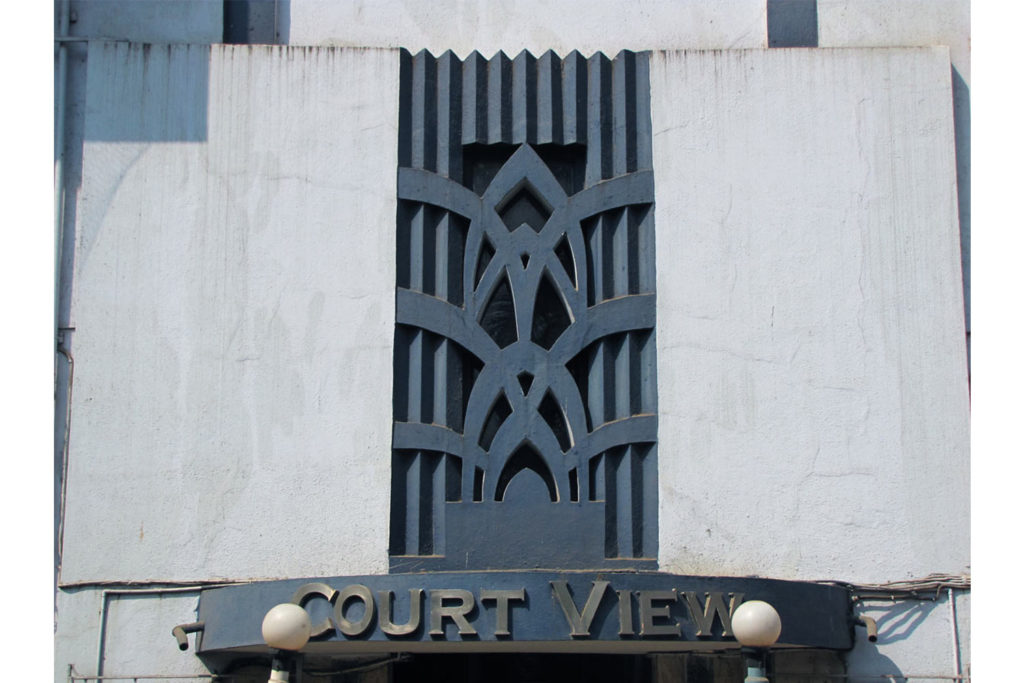
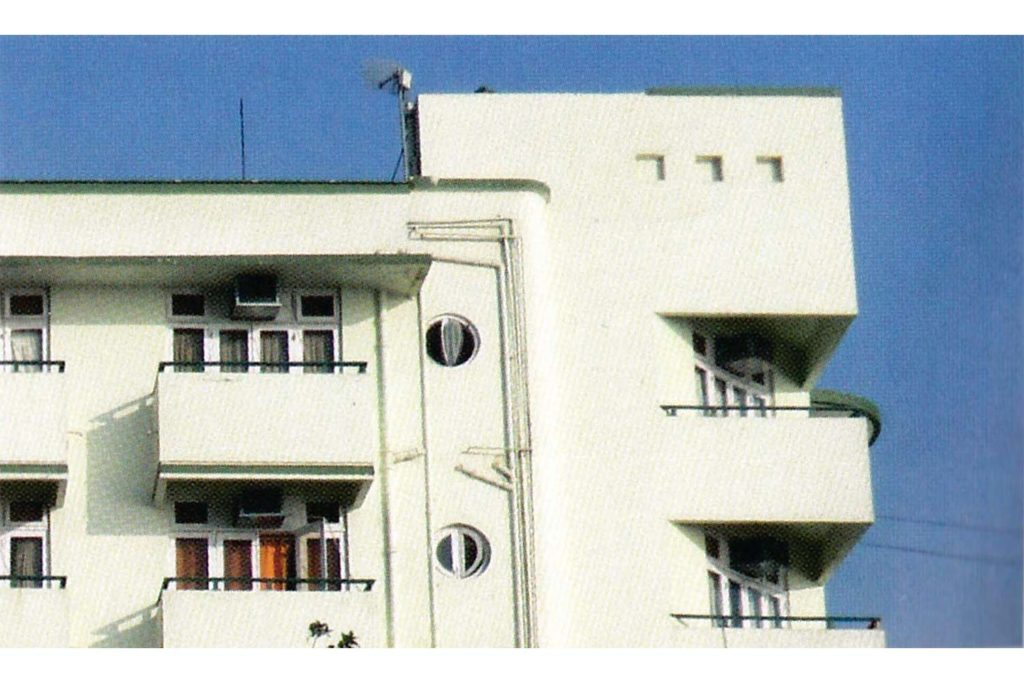
Conclusions
In choosing a semiotic viewpoint to observe architecture as texts, we sought to gain new knowledge about buildings that could not be discerned through conventional historic/stylistic writings. As was seen in the analysis, readings of building facades overcome barriers of time, and can make their contemporary context sufficiently transparent several years after they were built. Semiotic analysis of isotopy on the facades leads to connotative readings specific to the buildings themselves and creates correlation with geographical location (Bombay as a port city) as well temporal specificity (the rising urbanity of the early 20th century). Observed a-historically as a series of semes, the arrangement, layout, elements and ornament on facades of the Oval Maidan as well as the Marine Drive buildings make it possible to glean references to modernity that are spread fairly evenly across these buildings, and are obvious even today, some eight decades after they were constructed.
Let us now return the architecture to its historical context: while these two sets of buildings form the best known landmarks of the architectural expressions of the decades before independence, they are by no means the only examples. This new architecture was prolifically designed and constructed all over Bombay and the rest of India. This was possible because of the rise and consolidation of the first Indian practices of architects educated (largely) at the Sir JJ School of Art, Bombay. These Indian architects were home-grown in their education that was still rooted in the traditions and disciplines of the Beaux Arts that informed most of the buildings of the colonial enterprise.
These architects, through buildings like the Backbay ones moved away from these traditions a full two decades before freedom from the British and practiced an internationalism all their own. Green Fields was designed by the firm of Bhedwar & Bhedwar in 1936, a firm that would also design the iconic Eros Cinema at the northern end of the Oval Maidan set. Court View was designed by architect Maneckji Dalal, working with the firm of Merwanji Bana & Co. a year or two after Green Fields. On the Marine Drive, Sea Green6 was designed in the early 1940s by the prolific architect G B Mhatre, who also designed several buildings on the Oval Maidan stretch. The building, originally residential was soon converted to a hotel which continues to operate to this day. Soona Mahal dominates the Marine Drive skyline, and was also designed by G B Mhatre around 1940. In the making of these buildings these architects defied precedent, aligning themselves with the architecture of the United States, Miami in particular, rather than continue colonial revivalism. They used contemporary materials for building and contemporary processes of construction. They set up a typology of urban living (apartment living) and urban mobility. The buildings themselves articulate these modernist traits as has been seen in the identified isotopies.
The Oval Maidan buildings and the Marine Drive buildings are as much an expression of the architects’ aspirations as they are of their clients’ who were also Indians of wealth, education and widespread mobility. These facades from the 1930s and 1940s celebrated modernity by evoking a very contemporary glamorous, distinct, luxurious sensibility. These, with conventions of marine and water motifs, movement, dynamism and speed expressed through banding, and building lettering styles in contemporary Art Deco fonts, all being fashionably up-to-date. The layered ornament-semes and architectural-semes all form isotopies that connote a Modern aspect and aspiration through the invocation of speed, power, movement and contemporaneity.
The examination of the semiotics of these buildings demonstrates that they uniformly exude modernist meanings. It is possible to extrapolate from our findings that semiotic readings are possible for the rest of the Backbay buildings, and indeed others in Bombay of the same vintage. These are isotopies rich for the picking, given the number and variety of buildings built in the second quarter of the new century. We conclude, therefore, that Bombay’s buildings of the 1930s and the 1940s form part of the forward looking modernist enterprise- one that broke away from tradition and history and displaced location, creating broader universal readings. This is observed in the narrative isotopy of the facades, which can be indexical/symbolic of modernity in the 20th Century.
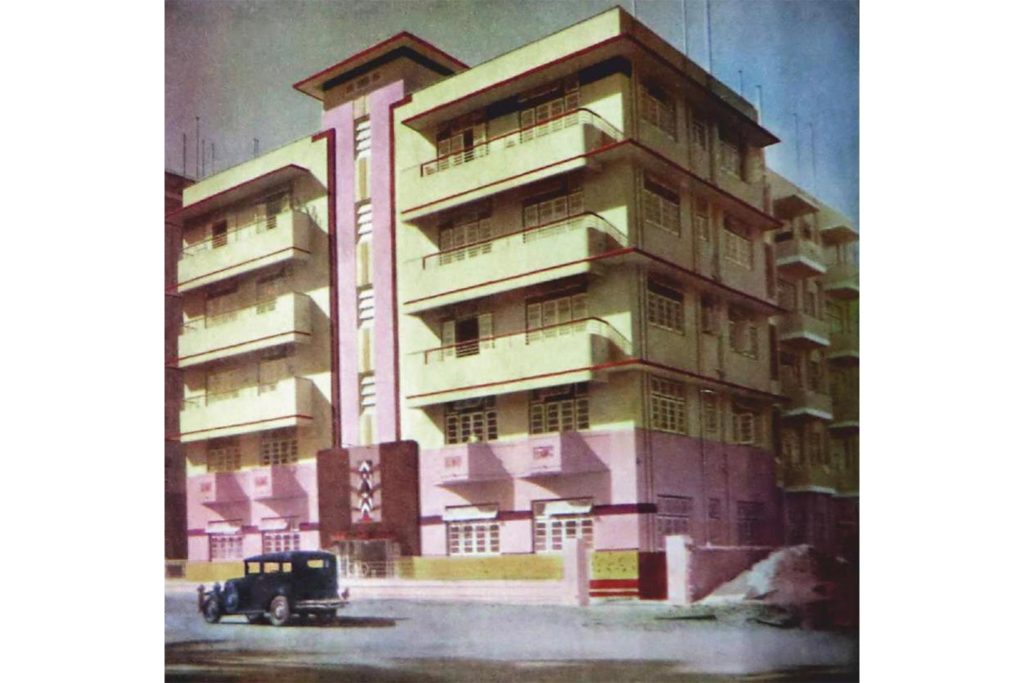
Acknowledgements
I acknowledge the continued guidance and encouragement of Prof. Ravi Poovaiah, my Research Supervisor at the IDC, IIT-Bombay.
Notes
1 Modernity can in certain contexts be conflated with contemporaneity. Here it is seen as a historical category that emerges in the wake of the Industrial Revolution and comes to fruition in the early 20th century. Modernity is marked by cultural productions that reject history and tradition, embrace the new technologies and processes of the period and have strong humanist and socialist ideologies. The first time the term is seen is in Charles Baudelaire’s 1864 essay ‘The painter of Modern Life’, while Adorno in 1973, presents modernism as a fetishizing of commodities.
2 In a text or a narrative, an isotopy is a repetition of a basic meaning trait, or seme that establishes some level of familiarity within the story and allows for a uniform reading/interpretation of it. Isotopy, according to Greimas (1966) are “a redundant set of semantic categories which make possible the uniform reading of the story” (as cited in Hebert, 2009).
3 The nucleus foregrounds the core around which the internal relations, among parts, that constitute the object are articulated (Mattozzi, 2007). In the context of the paper, the nucleus acts as a vertical axis around which the general symmetry of the object/ building is pivoted.
4 A sub-formant (an entity derived from the plastic configuration of an object/ building that is identified as a singularity) highlights the internal relations, among parts, that constitute the object (Mattozzi, 2007).
5 While Art Deco is a post facto appellation, that became common from the 1960, the Style Moderne was a phrase in use contemporaneously, and reflected the spirit of the age.
6 In Mehrota and Dwivedi’s ‘Bombay Deco’ both Sea Green and Soona Mahal are identified as the designs of the architectural firm Suvarna Patki &Vora. Navin Ramani in ‘Bombay Art Deco’ identifies both buildings as designed by G B Mhatre. We have gone with Mhatre in the text as the designs of Sea Green and Soona Mahal reflect several of Mhatre’s architectural flourishes. However the provenance of the designer’s need to be further established.
Dr. Mustansir Dalvi is Professor of Architecture at Sir JJ College of Architecture, Mumbai. He has lectured, read and published several papers and books on architectural history and heritage. He is particularly interested in the development of Indian Modernism in the early 20th century, seen through its expressions in the architecture of the time. In his doctoral research completed at the IIT-Bombay (IDC), he has charted a semiotic of Bombay’s Art Deco Architecture.
This article has been reproduced with permission from the author. It originally appeared in the Tekton Journal Volume 2 Issue 1, March 2015 pp. 56-73.

